Right-clicking the ClipboardFusion system tray icon will show this menu, allowing you to access the Settings, toggle the Trigger command, run Triggers on the current clipboard text, and more.
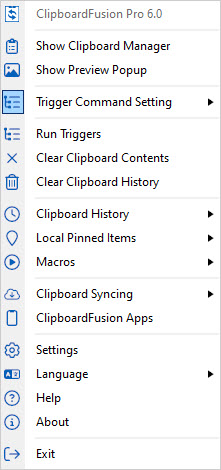
- Show Clipboard Manager: Click this button to show the Clipboard Manager window.
- Show Preview Popup: Click this button to show the Preview Popup. It will show either an image preview, HTML colour code preview, or plain text, depending on what is currently on the clipboard.
- Trigger Command Setting: This sub-menu allows you to choose whether or not Trigger rules should be processed automatically when copying text.
- Run Triggers: Click this item to process the Triggers on the current clipboard contents.
- Clear Clipboard Contents: Click this menu item to clear the current clipboard contents. After doing this, pressing Ctrl + V will not paste anything until the next time something is put on the clipboard.
- Clear Clipboard History: Click this menu item to clear the Clipboard History list.
- Clipboard History: This sub-menu allows you to see the most recent 10 History items. Click the "Show Clipboard History Tab" menu item to view the full list in the Clipboard Manager.
- Local Pinned Items: This sub-menu allows you to see the first 10 Local Pinned items. Click the "Show Local Pinned Tab" menu item to view the full list in the Clipboard Manager.
- Macros: This sub-menu allows you to select a Macro to run on the current clipboard contents.
- Clipboard Syncing: This sub-menu allows you to adjust settings related to syncing your items to the ClipboardFusion servers.
- Online Recent Items: This sub-menu allows you to see the 10 most recent Online Recent (synced) items. Click the "Show Online Recent Tab" menu item to view the full list in the Clipboard Manager.
- Online Pinned Items: This sub-menu allows you to see the first 10 Online Pinned (synced) items. Click the "Show Online Pinned Tab" menu item to view the full list in the Clipboard Manager.
- ClipboardFusion Apps: Click this menu item to open a website that lists all of the available ClipboardFusion mobile apps.
- Settings: Click this menu item to open the ClipboardFusion Settings window.
- Language: This sub-menu allows you to change the UI language that ClipboardFusion is displayed in.
- Help: Click this menu item to go to the online ClipboardFusion help guide.
- About: Click this menu item to open the About screen for ClipboardFusion.
- Exit: Click this menu item to Exit ClipboardFusion completely.
The Trigger Command Setting sub-menu allows you to disable and enable automatic Trigger processing on copied text.
- Disabled: Click this menu item to disable Triggers from automatically running.
- Enabled on Copy: Select this item to have the Trigger rules be processed every time something is copied to the clipboard.
- Enabled on Double-Copy: Click this menu item to have Triggers run when Ctrl + C is pressed twice in succession.
- Enabled Except on Double-Copy: Click this menu item to have Triggers always run, unless Ctrl + C is pressed twice in succession.
The Clipboard Syncing sub-menu allows you to enable or disable syncing, sync the current clipboard text, toggle automatic sync on ever copy, or open your ClipboardFusion account page.
- Enable Clipboard Syncing: Click this menu item to enable syncing with the ClipboardFusion servers.
- Disable Clipboard Syncing: Click this menu item to disable syncing with the ClipboardFusion servers.
- Sync Current Clipboard Text Now: Click this menu item to add the current clipboard text to the Online Recent list. It will be synced to the ClipboardFusion servers.
- Sync All Copied Text Automatically: Click this menu item to have all copied text automatically synced to the ClipboardFusion servers. Each copied item will be added to the Online Recent list.
- Manage My Account: Click this menu item to open your account page on the ClipboardFusion website.
The Language sub-menu allows you to choose which language the ClipboardFusion UI should be in.
- Show Full List: Click this menu item to open the Settings > Languages tab.
The Clipboard Manager is where you'll spend most of your time. The five tabs in the Clipboard Manager from left to right are Local History, Local Pinned, Online Recent, Online Pinned, and Macros. You can disable or re-enable any of the tabs by right-clicking on any tab in the Clipboard Manager window. You can also right-click on any entry in the lists to perform actions like running Macros on them, pinning them, removing them, and more.
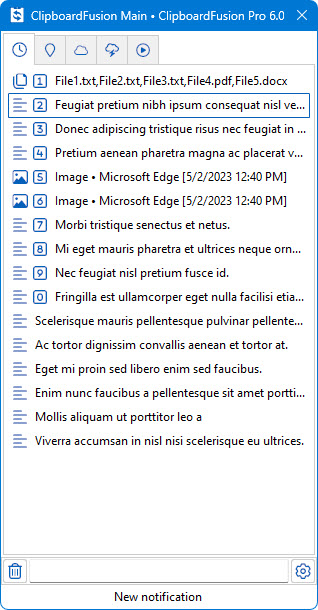
- No lists are enabled: This text will show up if you've disable all of the Clipboard Manager tabs. To re-enable the tabs, right-click anywhere in the Clipboard Manager window and select an entry from the menu.
- History: This tab lists all of your recently copied items. You can right-click on items to perform tasks like pinning the item, running Macros on it, and more.
- Pinned: This tab lists all of your locally pinned items. You can right-click on items to perform tasks like editing the item, running Macros on it, and more.
- Online Recent: This tab lists all of your recently synced online items. You can right-click on items to perform tasks like editing the item, running Macros on it, and more.
- Online Pinned: This tab lists all of your online pinned (synced) items. You can right-click on items to perform tasks like editing the item, running Macros on it, and more.
- Macros: This tab lists all of your ClipboardFusion Macros. Selecting one will run the Macro on the current clipboard contents. You can right-click the items to edit them or remove them.
- Clear the focused list: Click the clock icon to the left of the search box to clear the clipboard history list.
- Open the Settings Window: Click the gears icon to the right of the search box to open the Settings window.
When right-clicking an item on any of the Clipboard Manager tabs, you'll get a context menu with various options for working with the items. Some menu items are only available for items on specific tabs.
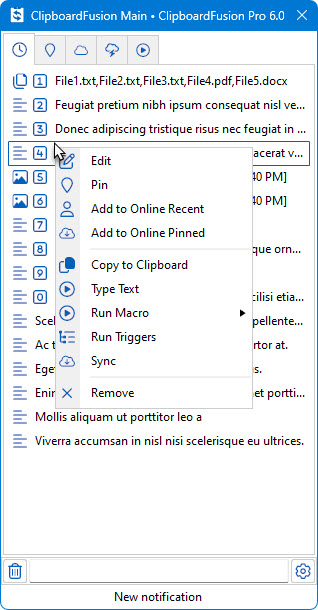
- Move Up: Click this menu item to move the selected item up the list. You can also drag and drop items to re-order them.
- Move Down: Click this menu item to move the item down in the list.
- Edit: Click this menu item to edit the selected item.
- Edit Name: Click this menu item to edit the selected item's friendly name. This is only available in the menu for Local and Online Pinned items.
- Pin: Click this menu item to add it to the Online Pinned list. It will stay synced with the ClipboardFusion servers.
- Unpin: Click this menu item to remove it from the pinned list.
- Add to Online Recent: Click this menu item to add the item to the Online Recent list. The item will be synced to the ClipboardFusion servers.
- Add to Online Pinned: Click this item to add it to the Online Pinned list. The item will be synced to the ClipboardFusion servers.
- Copy to Clipboard: Click this menu item to put the selected item on the clipboard.
- Save Image to File: Saves the selected image to a file, prompting for the filename.
- Type Text: Click this menu item to have ClipboardFusion type the text into the target window instead of pasting it.
- Run Macro: This sub-menu allows you to choose a Macro to run on the selected item.
- Run Triggers: Click this menu item to process your Trigger rules on the selected item.
- Sync: Click this menu item to initiate a sync with the ClipboardFusion servers.
- Remove: Click this menu item to remove it from the list.
- Open in Browser: Opens the selected item in the default web browser.
If you right-click any of the tabs in the Clipboard Manager (or in any blank space if all tabs are disabled), you can choose to enable and disable the tabs. Clicking an item in the list will toggle it between enabled and disabled.
The History tab is where you'll see all of your recently copied items. The newest item is at the top, and you can paste any item to the last focused window just buy clicking it in the list. If you want to set a History item on the clipboard without automatically pasting it, you can hold Shift on the keyboard while you click the item. You can then paste it later by pressing Ctrl + V.
The Pinned tab lists all of your items that have been pinned locally. These items are stored locally on your machine and not synced to the ClipboardFusion servers. If you right-click on an item, you can edit it, add it to one of the Online lists, remove it, and more.
The Online Recent tab lists your items that were recently synced to the ClipboardFusion servers. If you right-click an item, you can choose to pin it, edit it, remove it, and more.
The Online Pinned tab in the Clipboard Manager lists your items that have been synced and pinned to the ClipboardFusion servers. You can adjust the number of items shown on the Settings > Clipboard Syncing tab. If you right-click on an item, you can choose to edit the item, unpin the item, remove the item and more.
The Macros tab in the Clipboard Manager allows you to select a Macro to run on the current clipboard text. If you left-click on an item in the Macros tab, it will run that Macro on the current clipboard text. If you right-click an item, you can choose to run a sync, edit the Macro, or remove the Macro.
The Preview Popup will show a small preview of images or HTML colour codes that are currently on the clipboard. The Preview Popup can be disabled on the Settings > Options tab.
You can right-click the Preview Popup window to get a context menu that allows you to save the image file to your local hard drive, or close the Preview Popup.
- Save Image to File: If the current preview popup is for an image, click this menu item to save the image to your local computer.
- Close Preview: Click this menu item to close the preview popup window.
You can access the ClipboardFusion Settings window by clicking the "gears" icon in the lower-right of the Clipboard Manager window, or by right-clicking the ClipboardFusion system tray icon (on the taskbar, near the clock) and choosing "Settings."
The Settings window allows you to tweak features like the Clipboard Manager, Clipboard History, and Clipboard Syncing. You can also create rules on the Triggers tab for modifying text automatically when copying.
This tab in the Settings window allows you to log onto your Binary Fortress account, check for program updates, and modify application settings.
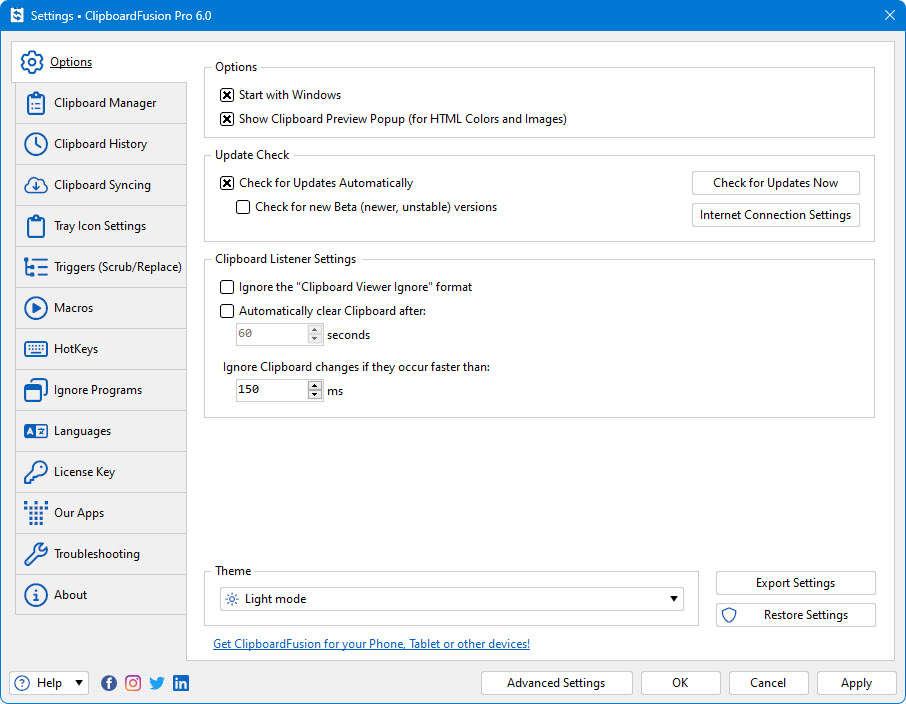
- Start with Windows: Enable this checkbox to have ClipboardFusion automatically start when you login to Windows.
- Show Clipboard Preview Popup (for HTML Colours and Images): Enable this option to allow ClipboardFusion to automatically show a preview popup when an image or HTML colour code is copied to the clipboard.
- Ignore the "Clipboard Viewer Ignore" format: Enable this checkbox to allow ClipboardFusion to capture clipboard contents even if they use the "Clipboard Viewer Ignore" format.
- Automatically clear Clipboard after: To have the clipboard contents get automatically cleared, enable this checkbox and set the timeout in seconds.
- Ignore Clipboard changes if they occur faster than: This option allows you to adjust how quickly clipboard changes need to occur before ClipboardFusion will ignore them. Some programs will set the clipboard multiple times in quick succession, so this option is helpful to prevent multiple History entries for each copy from those programs.
- Check for Updates Automatically: Enable this to let this application periodically check for updates.
- Check for new Beta (newer, unstable) versions: Enable this to let this application check for new Beta versions. This setting is not recommended unless you are interested in testing new software.
- Check for Updates Now: Perform an update check right now.
- Internet Connection Settings: Click this button to open the proxy settings window.
- Export Settings: Click this button to export your current application settings to a .REG file. You can use this backup file to import your settings to another machine, or use it to restore your settings if you are re-installing your machine.
- Restore Settings: Allows you to restore your settings from a previously created backup.
- Advanced Settings: Click this button to open the Advanced Settings window.
The My Licenses dialog allows you to view and load any license keys that are applicable for this product. If you don't see your purchased license listed, please contact us and we'll help track it down. This dialog can be accessed via the My Licenses button on the Settings > Options tab (when logged in).
- Name: This column displays the name of the user associated with the license.
- Date Created: This column lists the date that each of your licenses was created.
- License Type: This column lists the license type for each of your licenses.
- License Restrictions: This column explains the restrictions for the license type of each of your licenses.
- Expiry Date: This column lists the expiry date (if applicable) for each of your licenses.
- License Key: This column displays the license key.
On the Settings > Clipboard Manager tab, you can configure the behaviour of the Clipboard Manager window, including whether it stays open all the time, or closes after pasting an item. You can also choose where the Clipboard Manager window will open, the default tab to show when it opens, and more. Note that you can set a key combination for opening the Clipboard Manager on the Settings > HotKeys tab.
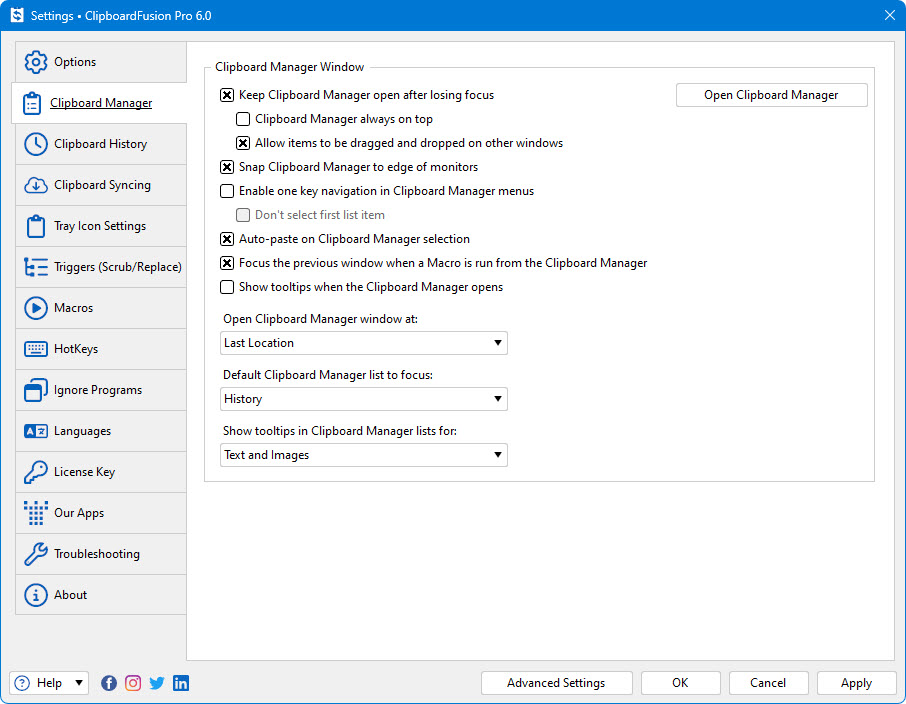
- Keep Clipboard Manager open after losing focus: Enable this checkbox to have the Clipboard Manager window remain open, even after pasting or switching focus to another application window.
- Clipboard Manager always on top: Enable this checkbox to have the Clipboard Manager window always be above other application windows.
- Allow items to be dragged and dropped on other windows: Enable this checkbox to allow dragging of items from the Clipboard Manager to other windows like text editors, image editing programs, etc.
- Snap Clipboard Manager to edge of monitors: Enable this checkbox to have the Clipboard Manager automatically snap into alignment with monitor edges when dragged near them.
- Enable one key navigation in Clipboard Manager menus: Enable this option to allow navigating the Clipboard Manager menus using only the HotKey. For example, if your "Show History Menu" HotKey is set to Shift + Ctrl + V, you can keep Shift + Ctrl pressed, and tap the V key multiple times to move the selection down the list.
- Don't select first list item: When this setting is enabled the history will open but it won't paste the first item.
- Auto-paste on Clipboard Manager selection: Enable this option to have ClipboardFusion automatically paste the selected item into the last focused textbox when clicked.
- Focus the previous window when a Macro is run from the Clipboard Manager: When you run a Macro from the Clipboard Manager window it will attempt to focus the previous window first.
- Show tooltips when the Clipboard Manager opens: When this option is enabled, the tooltip for the first item in the Clipboard Manager window will appear as soon as the Clipboard Manager is opened.
- Open Clipboard Manager window at: This option allows you to choose where to open the Clipboard Manager window. It can be opened at its last closed location, with the top left corner at the mouse cursor, centred over the mouse cursor, or centred over the last focused application window.
- Default Clipboard Manager list to focus: This option allows you to choose which list (History, Local Pinned, Online Recent, Online Pinned, Macros) to show when the Clipboard Manager opens. You can still open directly to another list by assigning a HotKey for opening that list.
- Show tooltips in Clipboard Manager lists for: This option allows you to show whether you want to see preview tooltips for text items, image items, or both.
- Open Clipboard Manager: Click this button to open the Clipboard Manager window.
On the Settings > Clipboard History tab, you can configure the behaviour of the History tab in the Clipboard Manager. You can choose the number of items to store in the history, the database location (if you prefer to have it somewhere other than the default), set hotkeys for pasting history and pinned items, and more.
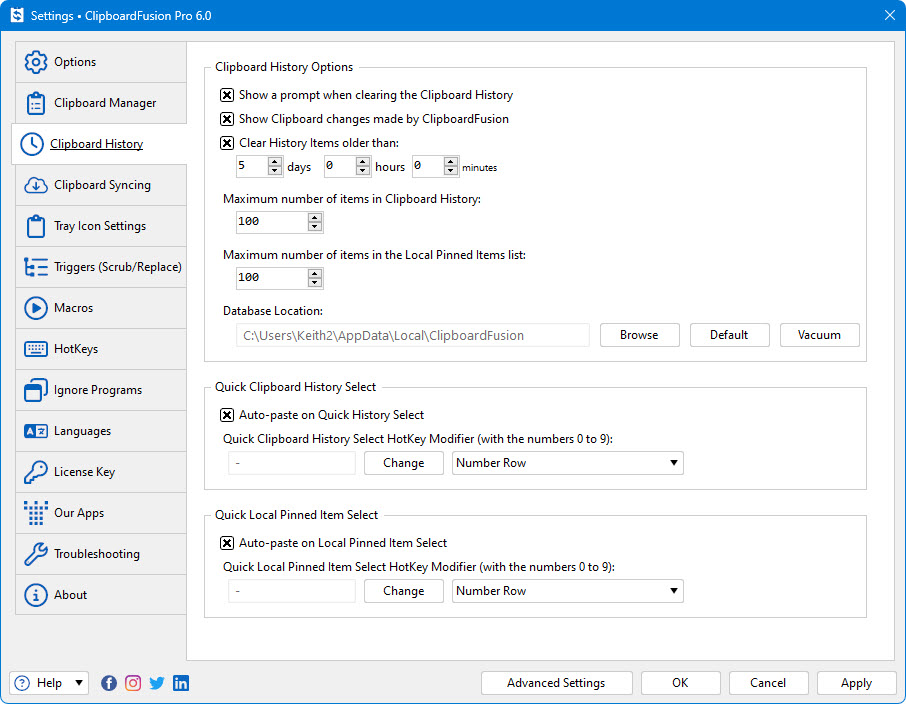
- Show a prompt when clearing the Clipboard History: Enable this option to require confirmation when clearing the Clipboard History list.
- Show Clipboard changes made by ClipboardFusion: Enable this checkbox to have the History list reflect changes made to the clipboard if those changes were made by ClipboardFusion. For example, with this option enabled, when you paste an item from one of the Clipboard Manager lists, it will show up as the most recent item in the History list.
- Clear History Items older than: To have ClipboardFusion automatically prune old items from the History list, enable this checkbox and set the item age in days, hours, and minutes. Items older than this will be permanently deleted from the History list. This setting does not affect Online Recent items or any other lists.
- Maximum number of items in Clipboard History: This option allows you to choose how many History items to keep in the list. The oldest ones are pruned periodically to keep the list at this maximum number of items.
- Maximum number of items in the Local Pinned Items list: This option allows you to choose how many Local Pinned items to keep in the list.
- Database Location: This box shows the current folder that the Clipboard History database is stored in.
- Browse: Click this button to choose a new folder to use for storing the ClipboardFusion local history database. The contents of this database are not synced to the ClipboardFusion servers.
- Default: Click this button to use the default location for the ClipboardFusion local history database.
- Auto-paste on Quick History Select: Enable this option to have ClipboardFusion automatically paste the item when using the Quick Clipboard History Select HotKey that you can set on the Settings > Clipboard History tab. If this option is disabled, the item will only be set on the clipboard, and you'll need to manually paste it.
- Quick Clipboard History Select HotKey Modifier (with the numbers 0 to 9): Click the Change button to choose the modifier keys to use for quickly selecting History items 1-10. For example, if you set this to Ctrl + Shift, you can then press Ctrl + Shift + 0 to paste the 10th item on the History list.
- Auto-paste on Local Pinned Item Select: Enable this option to have ClipboardFusion automatically paste the item when using the Quick Local Pinned Item Select HotKey that you can set on the Settings > Clipboard History tab. If this option is disabled, the item will only be set on the clipboard, and you'll need to manually paste it.
- Quick Local Pinned Item Select HotKey Modifier (with the numbers 0 to 9): Click the Change button to choose the modifier keys to use for quickly selecting Local Pinned items 1-10. For example, if you set this to Ctrl + Shift, you can then press Ctrl + Shift + 0 to paste the 10th item on the Local Pinned list.
On the Settings > Clipboard Syncing tab, you can configure whether ClipboardFusion syncs your copied text online, whether it does it automatically, and how many Online items you want it to keep on the local machine. If you have an account already, you can login in the "My Binary Fortress Account" section. If you don't already have an account, click the Register button to set one up. Note that a ClipboardFusion Pro license is required in order to be able to sync your items to the ClipboardFusion servers.
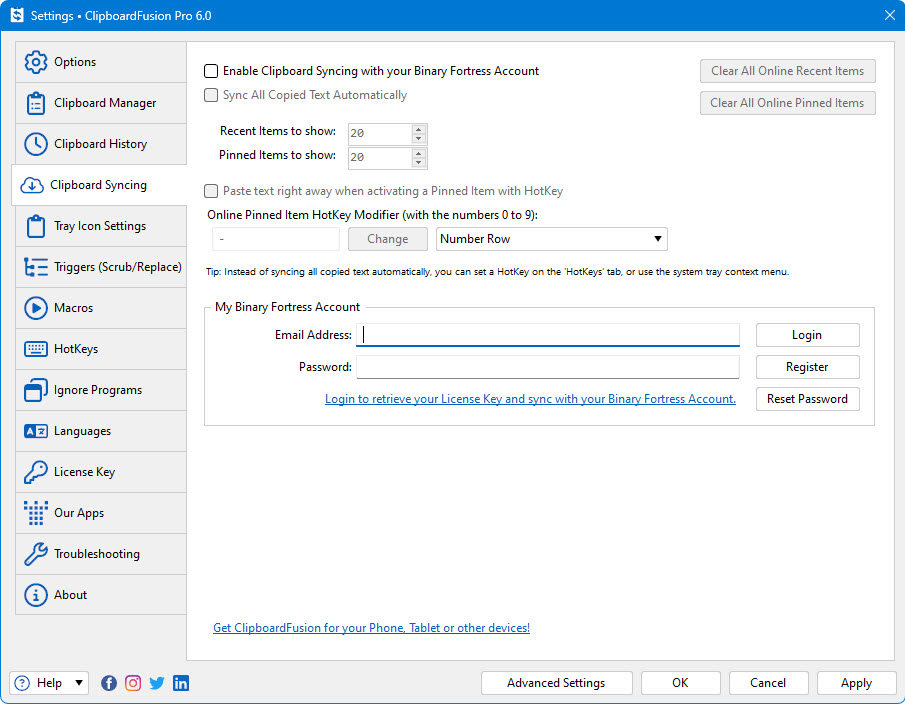
- Enable Clipboard Syncing with your Binary Fortress Account: Enable this option to allow ClipboardFusion to sync the Online Recent list, Online Pinned list, and Macros with the ClipboardFusion servers.
- Sync All Copied Text Automatically: Enable this option to have ClipboardFusion automatically save all copied text to the Online Recent list. The items in this list are synced with the ClipboardFusion servers.
- Recent Items to show: This option allows you to choose how many Online Recent items should be synced from the ClipboardFusion servers to this computer. The maximum is 75.
- Pinned Items to show: This option allows you to choose how many Online Pinned items should be synced from the ClipboardFusion servers to this computer. The maximum is 75.
- Paste text right away when activating a Pinned Item with HotKey: Enable this option to have ClipboardFusion automatically paste the item when using one of the quick select HotKeys that you can set on the Settings > Clipboard Syncing tab. If this option is disabled, the item will only be set on the clipboard, and you'll need to manually paste it.
- Online Pinned Item HotKey Modifier (with the numbers 0 to 9): Click the Change button to choose the modifier keys to use for quickly selecting Online Pinned items 1-10. For example, if you set this to Ctrl + Shift, you can then press Ctrl + Shift + 0 to paste the 10th item on the Online Pinned list.
- Clear All Online Recent Items: Click this button to clear all of your Online Recent items. This will remove them locally, and from the ClipboardFusion servers.
- Clear All Online Pinned Items: Click this button to clear all of your Online Pinned items. This will remove them locally, and from the ClipboardFusion servers.
In the "My Binary Fortress Account" section, you can enter your email address and password to enable easy retrieval of your license key.
- Email Address: Enter the email address for your Binary Fortress Account here.
- Password: Enter the password for your Binary Fortress Account here.
- Login: Enter your email address and password, then click this button to login to your Binary Fortress Account. Once logged in, you can retrieve your license key if needed.
- Register: If you don't already have a Binary Fortress Account, click this button to open the registration page.
- Reset Password: If you've forgotten your password, click this button to open the password reset page.
- Name: When logged in, the name on your account shows here.
- My Account: Click this button to access your account page on the our website.
- My Licenses: Click this button to view and apply your license key.
- Logout: Click this button to logout of your Binary Fortress Account. No items will be synced while logged out.
Right-clicking the ClipboardFusion system tray icon will bring up a context menu where you can choose to Show the Clipboard Manager, open the Settings window, toggle the Trigger Command Setting, and more. If you don't see the ClipboardFusion system tray icon on the taskbar, try clicking the "up" arrow next to the tray icons to access the hidden icons. From there, you can click and drag the ClipboardFusion icon down to the main area on the taskbar.
The tray icon can take on different appearances and overlays:
- Clipboard not filled in: The Windows clipboard is empty.
- Clipboard filled in: The Windows clipboard has data on it.
- White circle overlay: The ClipboardFusion clipboard listener is paused. ClipboardFusion will not run Triggers or add items to the Clipboard History list.
- Blue circle overlay: ClipboardFusion is currently syncing with the server.
- Green circle on overlay: ClipboardFusion has finished syncing and is up to date with the server.
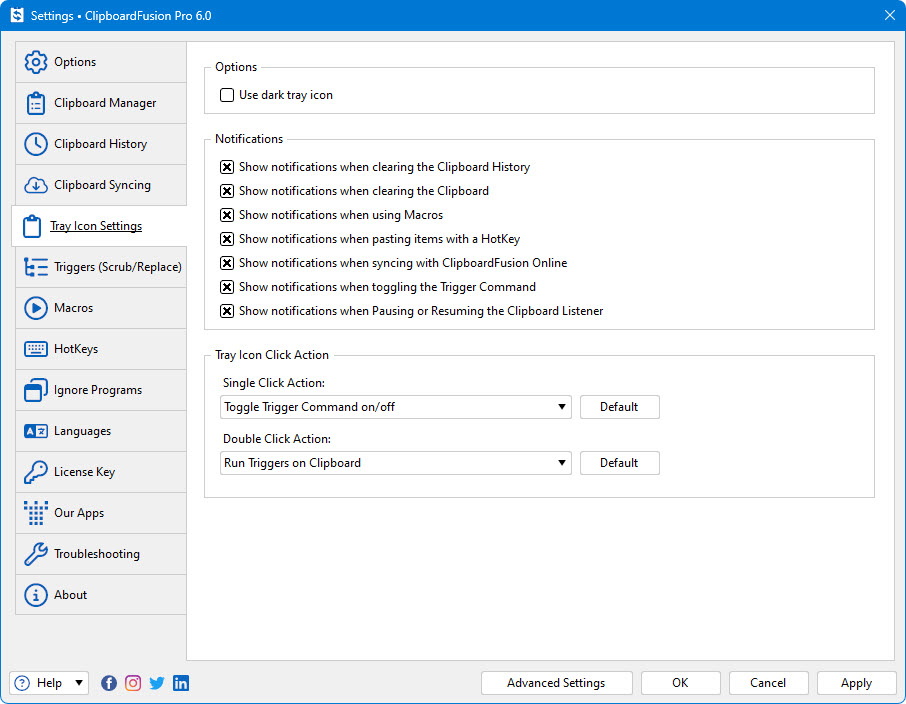
- Use dark tray icon: Enable this option to use the black tray icon instead of the white one. This is enabled by default on Windows 7 and 8 because the system tray hidden area has a white background.
- Show notifications when clearing the Clipboard History: Enable this option to show a tray notification when the History list is cleared.
- Show notifications when clearing the Clipboard: Enable this option to show a tray notification when the clipboard is cleared by ClipboardFusion. It will not notify if another application clears the clipboard.
- Show notifications when using Macros: Enable this option to show a tray notification any time a Macro runs.
- Show notifications when pasting items with a HotKey: Enable this checkbox to show a tray notification when pasting items using one of the quick select hotkeys that you can set on the Settings > Clipboard Manager and Settings > Clipboard History tabs.
- Show notifications when syncing with ClipboardFusion Online: Enable this option to show a tray notification when ClipboardFusion syncs with the ClipboardFusion servers.
- Show notifications when toggling the Trigger Command: Enable this option to show a tray notification when the Trigger Command is enabled or disabled.
- Show notifications when Pausing or Resuming the Clipboard Listener: Enable this option to show a tray notification when the Clipboard Listener is enabled or disabled.
- Single Click Action: This option allows you to choose what action will be performed when single-clicking on the ClipboardFusion system tray icon.
- Double Click Action: This option allows you to choose what action will be performed when double-clicking on the ClipboardFusion system tray icon.
- Default: Click this button to reset the Tray Icon Single Click Action to its default setting, which is "Toggle Trigger Command on/off."
Trigger rules allow you to perform multiple Actions on clipboard text. The rules can be triggered on a single copy (always), a double-copy (pressing Ctrl + C twice in succession), or except on double-copy (always except when pressing Ctrl + C twice in succession). Triggers can perform Actions like scrubbing formatting, replacing text, running Macros, and more. You can also specify the conditions of which the Trigger rule should be run, to have it run only on specific clipboard text.
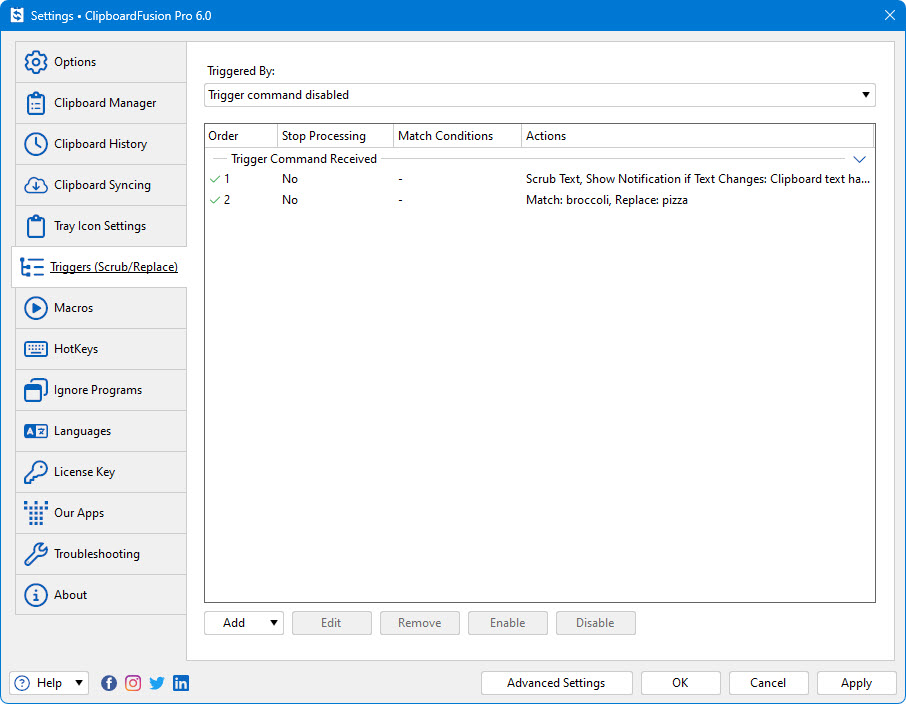
- Triggered By: This option allows you to choose whether Triggers will be run on every copy, only on double-copy (Ctrl + C twice in succession), on every copy except double-copy, or never. If you choose to disable the Trigger Command setting, you can still run the Trigger rules on items by right-clicking them in the Clipboard Manager and choosing "Run Triggers," or on the current clipboard contents by right-clicking the tray icon and choosing "Run Triggers."
- Order: This column lists the order that the Trigger rules will be processed in. Trigger rules can be re-ordered by dragging up and and down. Also note that each Trigger Event has its own order, as only the rules for the specific Trigger Event are processed on the clipboard contents.
- Stop Processing: This column lists whether or not the Trigger rule is setup to stop processing rules further down the order when it matches.
- Match Conditions: This column lists any specific match conditions that need to be met in order for the Trigger rule to run on the clipboard contents.
- Actions: This column lists the actions that are defined in the Trigger rule.
- Add: Click this button to add a new Trigger rule. This will open the Edit Trigger window.
- Edit: Click this button to open the Edit Trigger window for the selected Trigger rule.
- Remove: Click this button to permanently remove the selected Trigger rule.
- Enable: Click this button enable the selected Trigger.
- Disable: Click this button to disable the selected Trigger.
The Edit Trigger window allows you to create a defined set of Actions that should be taken on the clipboard text. If you specify conditions in the "Match Conditions" section, the Actions in the Trigger rule will only apply to clipboard text that matches those conditions. This window is accessed via the Edit (when Trigger selected) button on the Triggers (Scrub/Replace) tab in the settings window.

- Trigger is enabled: Enable this checkbox to have this rule run when Triggers are processed.
- Event: This drop-down allows you to choose what Event will cause this Trigger to run on the clipboard contents. You can choose from things like Trigger Command Received (single copy, double copy, etc), Clipboard Changed, ClipboardFusion Starts, and more.
- Process this Trigger if the Clipboard contains filenames: Enable this checkbox to have the Trigger rule run even when the clipboard contains files. In most cases you'll want to leave this disabled, as it can affect copying, cutting, and pasting files in File Explorer.
- Don't process Triggers after this one if matched: Enable this checkbox to have ClipboardFusion stop processing the Trigger rules on this clipboard text if this rule matches.
- Set Clipboard with the result of this Trigger: Enable this checkbox to have the clipboard text set with the final output from all of the Actions in this Trigger rule.
- Interval (sec): This field shows up if you choose Timer Interval from the Event drop-down. You can set the interval in seconds, and the Trigger rule will run on that interval.
- Clipboard Text: Enable this checkbox and specify some text if you want to limit this Trigger rule to running on specific clipboard text only. In the drop-down next to the Clipboard Text box, you can choose from different matching modes like Contains, Doesn't Contain, and even Regular Expressions.
- Match case: Enable this checkbox to have the specified Clipboard Text matching be case-sensitive.
- Process Filename: Enable this checkbox and enter the path to the program's EXE that you want to match. When you enable the checkbox, the Select Application window will automatically open, allowing you to choose from the list of running programs, or click Browse to browse directly to the EXE.
- Select Application: Click this button to choose a specific application that this Trigger rule should apply to. The rule will only run if the clipboard was set by the selected application.
- Process Command Line Parameters: Enable this checkbox and enter the command line parameters of the program you want to match. Note that you need to be able to see these parameters in the "Command Line" column in the Windows Task Manager when the program is running for this to work. Many applications will clear their command line parameters after launching, so this Match Condition is only used in very specific cases.
- Window Text: Enable this checkbox to specify all or part of the window title of the program you want this Trigger rule to match. You can drag the target icon that's to the right of this field and drop it on the program window to automatically get its window title. You can also do complex matches here, for example, Notepad +(file1 file2) which would match Notepad windows, only if they have file1 or file2 in the title. Click the question mark next to this field to see the full syntax for doing complex matches.
- Window Class: Enable this checkbox to specify all or part of the window class of the program you want this Trigger rule to match. You can drag the target icon that's to the right of this field and drop it on the program window to automatically get its window class. You can also do complex matches here. Click the question mark next to this field to see the full syntax for doing complex matches.
- Action: This column lists the Actions that the Trigger rule will perform if it matches the clipboard Match Conditions.
- Other: This column lists any details of the Action if applicable.
- Add: Click this button to add a new Action to the Trigger rule. There are many Actions to choose from including: Scrub Text, Text Replace, Run Macro, and more.
- Edit: Select an Action from the list and click this button to edit it.
- Remove: Select an Action from the list and click this button to remove it.
Triggers can perform many actions on the clipboard text, including scrubbing the text (removing whitespace, HTML, etc), replacing text, running Macros, and more.
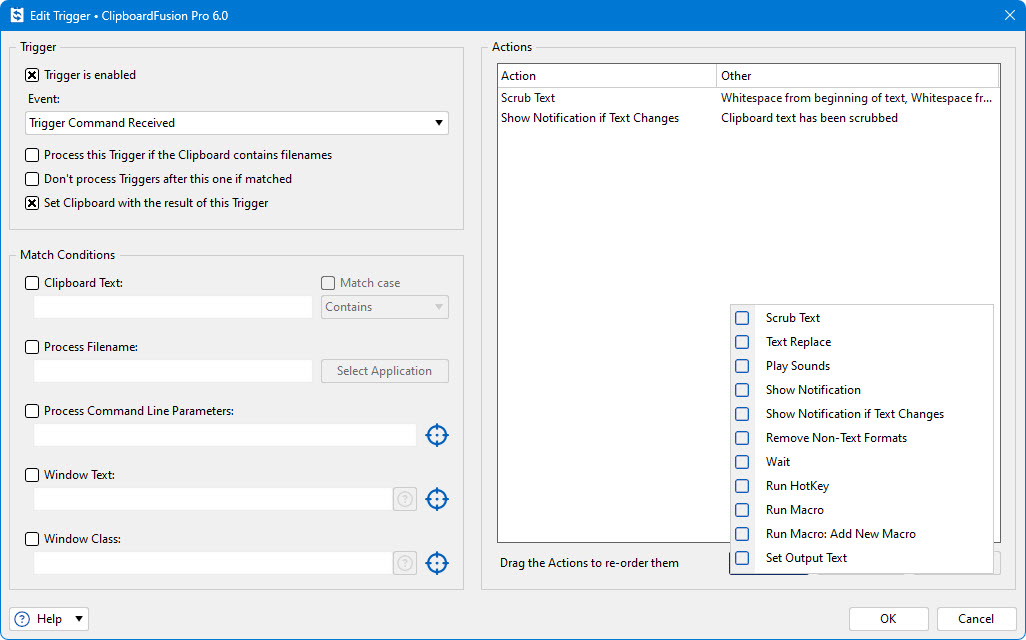
- Scrub Text: This menu item allows you to configure a Scrub Text action to remove formatting, HTML code, and tabs from the clipboard text.
- Text Replace: This menu item allows you to configure a Text Replace action for replacing all instances of the specified Match Text with the new Replace Text.
- Play Sounds: This action allows you to choose a sound file that should be played when the Trigger rule is run.
- Show Notification: This action will show a custom tray notification when the Trigger rule is run.
- Show Notification if Text Changes: This action will show a custom tray notification only if the clipboard text has been altered by the Trigger rule when it is run.
- Remove Non-Text Formats: This action will remove any formats that are not text (files, OLE objects, images, etc) when the Trigger rule is run.
- Wait: This menu item allows you to add a delay action into the Trigger rule.
- Run HotKey: This menu item allows you to choose a ClipboardFusion HotKey function to run.
- Run Macro: This menu item allows you to choose an existing Macro to run.
- Run Macro: Add New Macro: This menu item allows you to create a new Macro and have it added to the list of Actions.
- Set Output Text: This action allows you to choose the text that this Trigger rule will output when it is run. If there are more Trigger rules in the list after this one, this text will be passed as the input text to the next rule in the list. If this is the last rule in the list, this text will be set on the clipboard.
The Settings > Triggers tab allows you to create Trigger rules that can be automatically or manually processed on clipboard text. With the Trigger Command Settings, you can have the Triggers run automatically every time text is copied, only when a copy is done twice in succession (e.g. pressing Ctrl + C twice, quickly), or only when a copy is not done twice in succession. You can also disable the Trigger Command, so that the Triggers are only processed if you manually run them via the system tray menu or a HotKey.
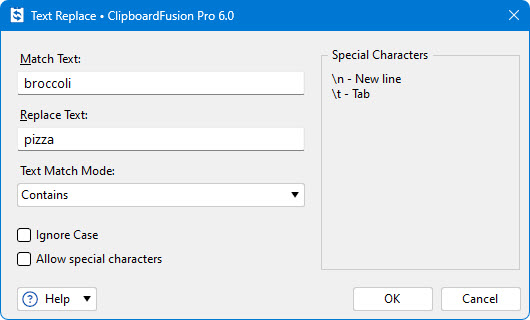
- Match Text: Set this textbox to the text that you would like to replace. (The "old" text)
- Replace Text: Set this textbox to the text that you would like to replace the Match Text with. (The "new" text)
- Text Match Mode: This option allows you to choose whether the text in the Match Text box should be matched normally (e.g. if the clipboard contents contain that text), or whether it should be treated as a Regular Expression.
- Ignore Case: Enable this checkbox to have the Text Replace rule be case insensitive.
- Allow special characters: Enable this option to allow special characters to be used in the Match and Replace text boxes. The special characters are \n for matching line breaks, and \t for matching tabs.
The Scrub Text action allows ClipboardFusion to automatically remove extra spaces, line breaks, and tabs from the start and end of the clipboard text, and also remove HTML code.
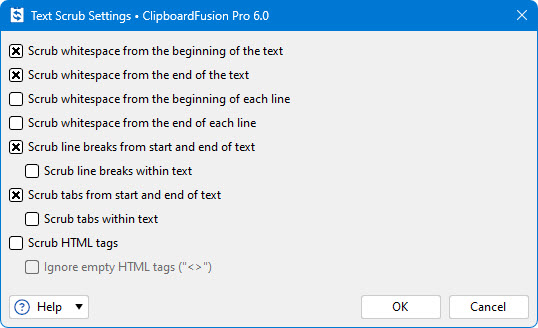
- Scrub whitespace from the beginning of the text: Enable this option to have the Scrub Text action remove any spaces that are before the start of the text on the clipboard when this Trigger rule is run.
- Scrub whitespace from the end of the text: Enable this option to have the Scrub Text action remove any spaces that are after the end of the text on the clipboard when this Trigger rule is run.
- Scrub whitespace from the beginning of each line: Enable this option to have the Scrub Text action remove any spaces that are before the start of each line in the text on the clipboard when this Trigger rule is run.
- Scrub whitespace from the end of each line: Enable this option to have the Scrub Text action remove any spaces that are after the end of each line in the text on the clipboard when this Trigger rule is run.
- Scrub line breaks from start and end of text: Enable this option to have the Scrub Text action remove any line breaks that are before the start and after the end of the text on the clipboard when the Trigger rule is run.
- Scrub line breaks within text: Enable this option to have the Scrub Text action remove all line breaks from the text on the clipboard when the Trigger rule is run.
- Scrub tabs from start and end of text: Enable this option to have the Scrub Text action remove any tabs that are before the start and after the end of the text on the clipboard when the Trigger rule is run.
- Scrub tabs within text: Enable this option to have the Scrub Text action remove all tabs from the text on the clipboard when the Trigger rule is run.
- Scrub HTML tags: Enable this option to have the Scrub Text action remove all HTML tags from the text when the Trigger rule is run.
- Ignore empty HTML tags ("<>"): Enable this option to exclude empty HTML tags when the Scrub HTML tags option is enabled.
This tab allows you to download and create scripted Macros for performing complex operations on clipboard text. Macros can be created using C# or VB .NET code.
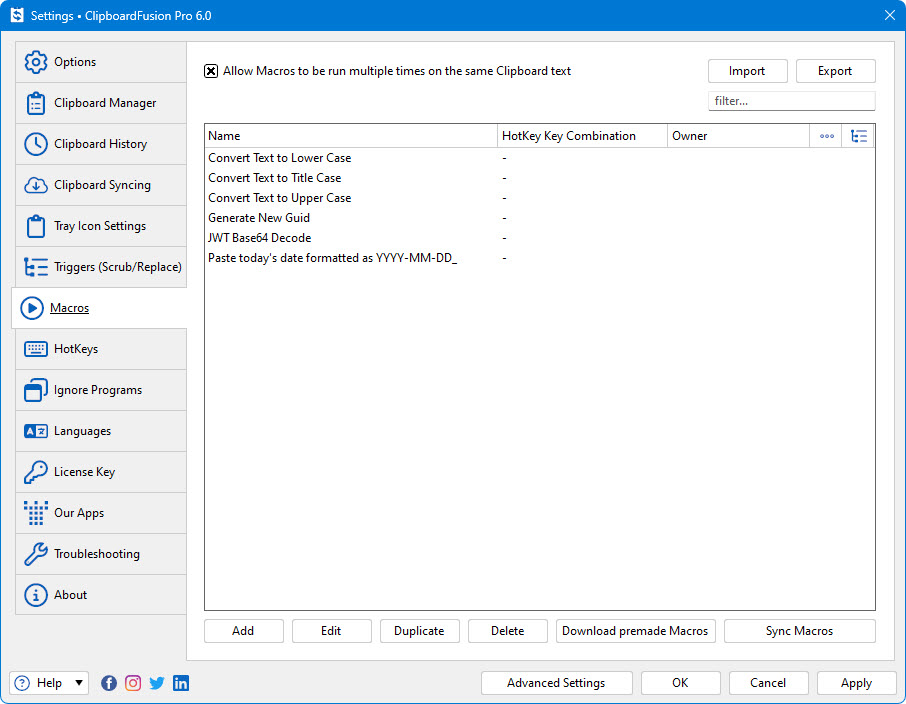
- Allow Macros to be run multiple times on the same Clipboard text: Enable this option to allow Macros to be run more than once on the same Clipboard text.
- Import: Click this button to import a macro from a .cfmacro file.
- Export: Click this button to export the selected macro(s) to .cfmacro files that can be imported on other machines.
- Name: This column lists the Macro names.
- HotKey Key Combination: This column lists the key combination assigned to the Macro. Pressing the key combination will run the Macro on the current clipboard contents.
- Owner: This column lists the name on the Binary Fortress Account that the Macro was synced from.
- Used by Tray Actions: If there is an icon in this column (fourth from the left), the Macro is in use by one of the Tray Icon Click Action settings on the Tray Icon Settings tab in the settings window.
- Used by Triggers: If there is an icon in this column (fifth from the left), the Macro is in use as an action in a Trigger rule on the Triggers (Scrub/Replace) tab in the settings window.
- Add: Click this button to add a new Macro. This will open the code editor window.
- Edit: Click this button to open the code editor window for editing the selected Macro.
- Duplicate: Click this button to duplicate the selected Macro. The duplicate will be created with "(Duplicate)" appended to the name.
- Delete: Click this button to permanently remove the selected Macro.
- Download premade Macros: Click this button to open the list of premade Macros that are available to download. Double-click a Macro in the list to open the code editor so that you can review the code before saving it.
- Sync Macros: Click this button to sync your current set of Macros to the ClipboardFusion servers.
This tab allows you to set key combinations on a number of different functions, including functions for opening each specific tab in the Clipboard Manager window.
- Action: This column lists the action that the HotKey will perform.
- Key Combination: This column lists the key combination assigned to the HotKey action.
- Edit: Click this button to open the edit key combination window for the selected HotKey function.
- Reset HotKeys: Click this button to reset all HotKeys to their defaults.
On this tab, you can add programs to the list of programs that ClipboardFusion should ignore. If a program is on this list, its text won't show up in the History menu, won't be synced online, and Trigger rules (text scrubbing, text replace, etc) will not run on text that this program puts on the clipboard.
- Name: This column lists the language name.
- Path: This column lists the path to the executable of the ignored program.
- Add: Click this button to browse for a program to add to the list of programs that should be ignored by ClipboardFusion. This is great for things like password managers where you don't want the copied text to end up in the History or Online Recent items.
- Remove: Click this button to remove the selected program from the list of programs that should be ignored by ClipboardFusion.
This tab in the Settings window contains a list of all the languages currently installed on your system for use.
- Name: This column shows the name of the language.
- Version: Shows the version for the Language file. This version should match the program version for best compatibility.
- Translators: Shows the contributors for the Language file.
- Complete: What percent complete the language file is.
- Help Finish a Translation: Help us finish a translation and receive a free Pro Standard license in return.
This tab in the Settings window displays your current License key, and allows you to update the License Key or revert to the free version.
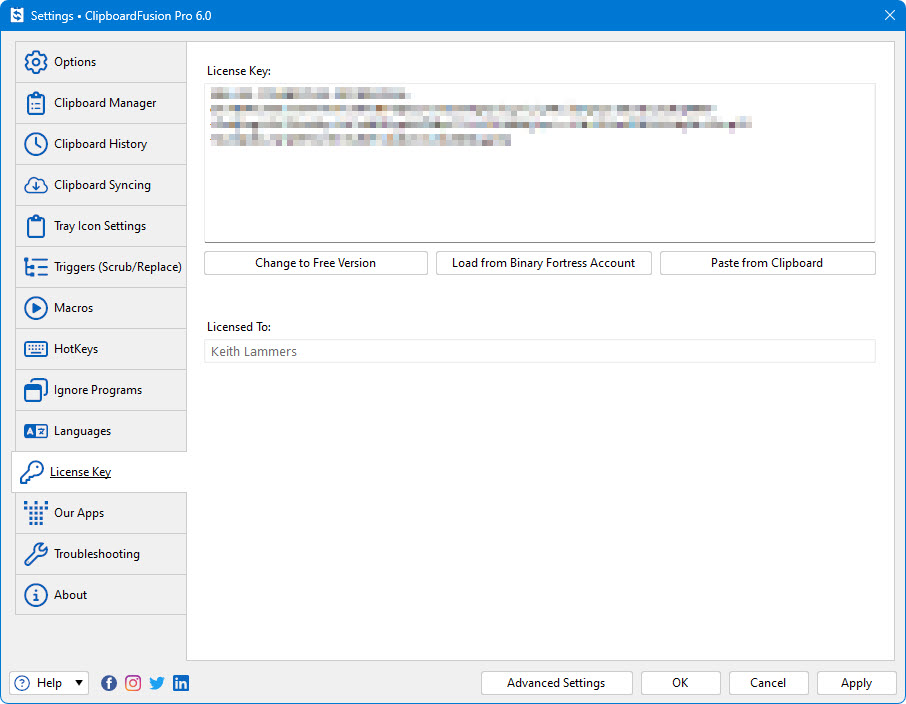
- License Key: The License Key that this application is currently using.
- Change to Free Version: At any time during the free 30-day Pro trial, you can click this button to revert back to the Free version of this application.
- Restore Trial License Key: This allows you to restore a trial license key if it was removed in error and is still valid (within 30 days).
- Load from Binary Fortress Account: Click this button to retrieve and select a license key from a list of license keys tied to your Binary Fortress account.
- Paste from Clipboard: If you have copied your license key from your email, just click this button to automatically paste it into the License Key box.
- Buy a License Key: If you're currently on the Free or Trial version, and you'd like to purchase a lifetime Pro license, click this button to be taken to the purchase page.
- Licensed To: Shows who the license key is registered to, and if it is a Site License key.
- License Expiry Date: If you are using a Trial license, this will show when it will expire.
- Request New Trial License: Click this button to submit a request to the Binary Fortress Software support team for a new 30-day trial license key.
The code editor window allows you to write function code in C# or VB .net. There are scripting API functions available in VoiceBot, DisplayFusion, and ClipboardFusion. If you start typing "BFS." the auto-complete will pop up a list of scripting functions that you can use. You can also use any regular C# or VB .NET code.

- Name: Enter a name for your macro here.
- Key Combination: This box shows the currently assigned key combination. If it's blank, there's no key combination currently set.
- Language: This drop-down lets you choose between using C# and VB.NET for your Scripted Function code.
- Edit: Click this button to set or edit the key combination assigned to this macro.
- References: Any DLLs that your Scripted Function code requires need to be listed here. For custom DLLs (that aren't in system folders) you'll need to specify the full path to the DLL. To add or remove references, right-click any entry in this pane.
- Undo (Ctrl + Z): Click this button to undo the last code change you made.
- Redo (Ctrl + Y): Click this button to re-do a change that you have just undone.
- Insert BFS Code: Click this button to insert a built-in code function at the cursor location.
- Verify Function: Click this button to verify that the code in the Scripted Function will compile, without running the Function.
- Run Function: Click this button to run the Scripted Function code as-is.
- Share your code with the community: Click this button to submit your Scripted Function to Binary Fortress. We will review the code and post it to the online repository so that other customers can download it.
The Our Apps tab lists some of our other popular applications. If you enjoy using this application, feel free to check out our other applications as well!
The troubleshooting tab contains information and options that are only useful for troubleshooting when something isn't working correctly. The text area contains all the information required by Binary Fortress Support when submitting a help request. The button with the blue arrows allows you to refresh the information listed here.
The Logging drop-down list allows you to set the Debug Logging Level. This typically only needs to be enabled when requested by the Binary Fortress support team.
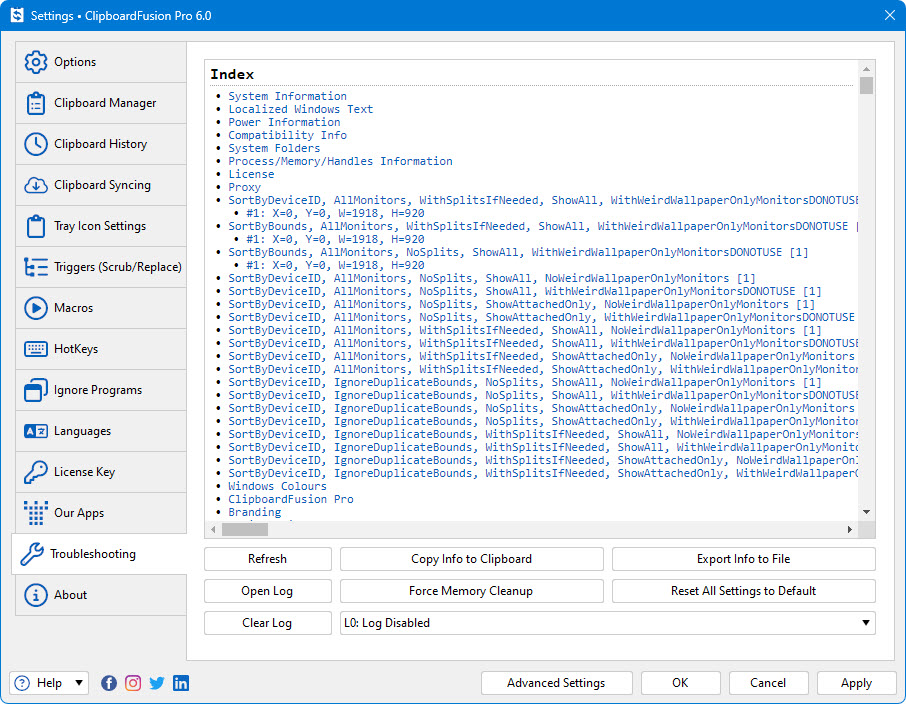
- Open Log: Opens an explorer window to the debug log file's location so you can attach it to an email, or upload it to the support forum.
- Clear Log: Clears the application debug log
- Refresh: Click this button to refresh the troubleshooting info.
- Force Memory Cleanup: This forces the application to pause and do a memory cleanup (a garbage collection) to try and free up any unneeded memory.
- Copy Info to Clipboard: Copies the information from the text area to the clipboard – you can paste this information into an email or forum post by pressing Ctrl + V.
- Log Level: This drop-down menu allows you to choose the logging level for debug logs. L0: Log Disabled is recommended for normal usage. You'll typically only want to enable debug logging to capture a log of a reproduceable issue when submitting a support request.
- Export Info to File: This will open a Save File dialog that will let you save your troubleshooting info to a file.
This dialog allows you to customize to connect to the internet to search for updates or to sync settings and profiles with your Binary Fortress account. This dialog can be accessed via the Internet Connection Settings button on the Options tab.

- No Proxy Server (direct internet connection): Select this option if you do not want this application to use a proxy server when accessing the Internet.
- Use System Proxy Server Settings: Select this option to have this application use the proxy settings that are configured in Internet Explorer.
- Use Custom Proxy Server Settings: Select this option if you would like to manually enter your proxy server information.
- Server Address: Enter the proxy server IP address or host name in this text box.
- Port: Enter the proxy server port in this text box.
- Username: Enter the username for your proxy server in this text box.
- Password: Enter the password for your proxy server in this text box.
- Re-enter Password: Re-enter the password (if required) for your proxy server in this text field.
- Save: Save the current proxy settings.
You can use these Advanced Settings to control hidden options. This window is accessed via the Advanced Settings button at the bottom of the main Settings window. For more information on what these settings control, please visit the
Advanced Settings guide.
- Only show modified values: Only show advanced settings that have a value assigned.
- Filter: The filter box allows you to search for advanced setting names. It uses the Binary Fortress Text Query syntax.
- Setting: Shows the category and name of the hidden setting that you can edit.
- Value: Shows the current value, and highlights the setting in red if there is a value set.
- Default Value: Restores the selected setting to its default value.
This window allows you to select from a list of currently running applications, or browse for an application on your computer. This window can be accessed via the Browse button on the Settings > Other Application tab.
- Application: Shows the application's name.
- Path: Shows the application's path.
- Filter: The filter box allows you to search for application paths. It uses the Binary Fortress Text Query syntax.
- Refresh: Click this button to refresh the list of open applications.
- Browse: Allows you to browse and select an application that isn't currently listed.
- Drag this over a window to select that window's process in the list automatically: When you drag this target icon over a window, any information about that window will be filled out automatically, like it's title, or class.
This window is displayed when a new version of the application is available.

- New Version: Shows the version number of the new version, and whether or not it is a beta release.
- Current Version: Shows the version you are currently using.
- Update Size: Shows the download size of the update.
- What's New in this Version: This shows the changes that have been made to this application since the last time you installed an update. It is a helpful guide to see what new features will be available in the new version.
- Install Now: Automatically downloads and installs the update with only 1 click. (Pro only)
- Install on Exit: Automatically downloads and installs the update after you exit the program, as long as the computer isn't shutting down. (Pro only)
- Visit Website: Opens your default web browser to the application download page so you can download the latest version.
- View Change Log: Opens your default web browser and shows the Change Log. This will allow you to see what has changed since the previous version.
- Skip This Version: Closes the update window, and tells this application to never remind you about this version. Newer versions, and forcing the update check manually using the "Check Now" button will still cause the update window to appear later.
- Remind Me Later: Closes the update window, and allows this application to remind you about the update later.
This window allows you to submit a support request, along with your Troubleshooting information and debug log (if debug logging is enabled on the Troubleshooting tab in the settings window). This window can be accessed via the Help dropdown at the bottom left of the Settings window.
- Name: Enter your email address in this text box.
- Email Address: Enter your name in this text box.
- Subject: Enter a quick one line description of your issue in this text box.
- Message: Enter a message explaining the issue that you're running into. If you clicked the Support Request button on an error message window, the error text will also show in this text box.
- Attach File: This will add an attachment to your support request.
- Clear Attachments: This will clear all attachments from your support request.
- Include a settings backup with this support request: Enable this checkbox to send a backup of your product registry Settings along with the support request.